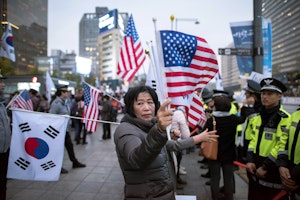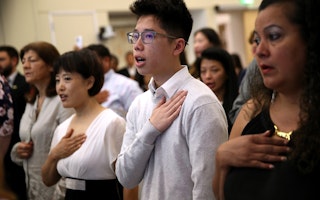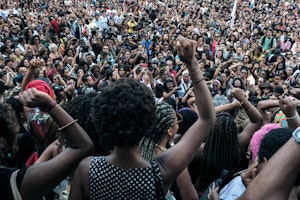Aryeh Neier Remembers Ruth Bader Ginsburg
By Aryeh Neier

In October 1970, on becoming the national executive director of the ACLU, I set out to create a Women’s Rights Project.
In my previous position as executive director of the ACLU’s New York affiliate, we had been involved in a handful of women’s rights cases. The rebirth of a feminist movement in the late 1960s made it plain that the issue would loom large in public policy, and I wanted the ACLU to spearhead the struggle in the courts.
It took me some time to secure ACLU board approval and to obtain funding. In 1971, I began a search for a director. Colleagues told me there was a law professor at Rutgers who had done good work on women’s rights for the New Jersey ACLU, so I called Ruth Bader Ginsburg and arranged to see her. She made a good impression, but what dazzled me was the quality of her written work. I offered her the post of director of the Women’s Rights Project.
There was a complication, however.
Top-ranked law schools were just beginning to add women to their faculties, and Columbia Law School made Ruth an offer to become their first tenured female professor. She didn’t want to turn down this offer. Fortunately, the dean of Columbia Law School, Mike Sovern—later, the president of the university—was a friend with whom I had worked closely at the New York Civil Liberties Union, and was himself a leading litigator in race discrimination cases. We made an arrangement that allowed Ruth to accept both posts, and we shared her salary. With Mike’s blessings, Ruth spent the great bulk of her time at the ACLU. Some of her law students volunteered to do research for her ACLU cases.
In news stories about Ruth, she regularly is described as “cofounder” of the ACLU Women’s Rights Project. I was concerned that though Ruth was a brilliant lawyer, she was not well connected to the emerging feminist movement. And I wasn’t sure how much time her duties at Columbia would consume. With Ruth’s enthusiastic support, I hired another lawyer, Brenda Feigen Fasteau, who became the other cofounder of the project. Whereas Ruth was shy and reserved, Brenda was outgoing and an active participant in the feminist movement. Ruth was in charge, but always treated Brenda as her equal.
Before taking up her post as director of the Women’s Rights Project, Ruth wrote the Supreme Court brief in Reed v. Reed. It was a landmark case. It challenged an Idaho law that gave men a preference as executors of estates. Its larger significance was that it established that the Fourteenth Amendment’s guarantee of “equal protection of the laws” applies to discrimination on the basis of sex as well as race. Ruth won the case unanimously.
Ruth was always eager to express her reliance on the work of others. In her brief to the Supreme Court in Reed v. Reed, she identified as co-counsel two stalwart feminists on the ACLU board, Dorothy Kenyon and Pauli Murray. Dorothy, an outspoken former judge in New York, had been a prime target of Senator Joseph McCarthy. After she testified at a Senate hearing, the great Herblock published a cartoon in the Washington Post showing McCarthy cowering in the Senate cloakroom and asking, “Is she gone yet?” Pauli was a gay, Black, feminist legal scholar—and a person of many other accomplishments—who had long argued that the Fourteenth Amendment should be invoked to address sex discrimination.
Ruth went on from Reed v. Reed to build a structure, brick-by-brick, that ultimately provided that the courts would give “heightened scrutiny” to cases involving sex discrimination. This was a step short of the “strict scrutiny” required in cases involving race discrimination. A number of news articles have pointed out that Ruth won five of the six cases she argued in the Supreme Court as director of the ACLU Women’s Rights Project. It was the one case she lost that probably prevented her from reaching her goal of “strict scrutiny.”
With state affiliates all over the country, the ACLU is a complex organization to administer. Its constitution requires “general unity without uniformity.” At one point, we discovered that a state affiliate had secured Supreme Court review of a case it had never reported to the national office. The case interfered with Ruth’s well-honed strategy to get the Supreme Court to require strict scrutiny. In an effort to rescue the case, which went against her strategy, Ruth persuaded the state affiliate to let her write the brief and argue the case in the Supreme Court. This did not succeed, and she lost the case that she never wanted to go to the Supreme Court.
Ruth was a wonderful colleague who became my personal friend. I enjoyed Ruth and her immensely supportive husband, Marty. While Ruth was reserved, Marty was extroverted, jovial, and a bon vivant. When President Carter appointed Ruth to the U.S. Court of Appeals for the D.C. Circuit, Marty gave up his highly lucrative law practice with a large New York law firm to become a law professor at Georgetown University. He did it to avoid any possible conflicts of interest for her in cases involving his law firm’s clients. Her career came first.
Marty died of cancer a decade ago. Had Marty lived, I think Ruth might have retired from the Court while President Obama could have nominated her successor. After he died, I think she was determined to keep going as long as she maintained her mental acuity. She did so until the end.

Aryeh Neier is president emeritus of the Open Society Foundations.


